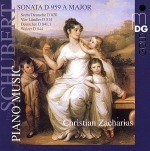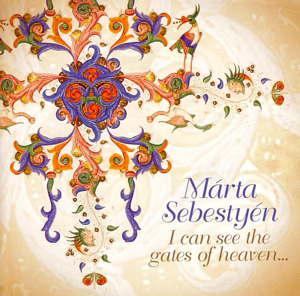
Márta Sebestyén I can see the gates of heaven… World Village 450009
- Performance:

- Sonics:

Imagine my surprise when I began to play what I naïvely assumed was a disc of Spanish music, only to discover the sounds of overtone chanting filling the room. Through them came another voice, low and haunting, with a special beauty that comes from inner illumination. I had entered the world of acclaimed Hungarian folk singer, composer and actress Márta Sebestyén.
Sebestyén, now 53, was all of seven when her economist father, who was then a visiting professor in the United States, brought home a large collection of ethnic music recordings from the Smithsonian. Hooked, his daughter began to learn the songs.
At 12, she won a folk song contest at her school. The contest was dedicated to composer Béla Bartók, who singlehandedly rescued scores of folk songs from oblivion. Her prize, granted by noted Hungarian ethnomusicologist Lásló Vikár, included a selection of recordings from the folk music archives of the Hungarian Academy of Sciences.
“…this new record opened up a new world and she was captivated by the magical power of the voices of authentic peasant performers,†Sebestyén writes in the liner notes to her first commercial recording in nine years. (The gap is incomprehensible, given the haunting beauty of her contributions to the movie The English Patient, the Japanese animated movie Only Yesterday, and Towering Inferno’s recording, Kaddish).
“She listened to the record day and night and hummed the tunes. The faces of the singers and the villages appeared in her fantasy – one day they would become real to her… Of course, many found her passion peculiar. They didn’t understand why a Budapest elementary school girl needed the texts, voices and melodies that sounded foreign to the ear of a city person… [Then], in the hands of a devoted and enthusiastic singing teacher [Lásló Lukin], an opportunity to create a singing community opened up…â€
Forty years later, two songs collected by Bartók and one by Vikár appear on Sebestyén’s World Village CD. Weaved into medleys of multiple songs, they are vital parts of two of the marvelous recording’s eight haunting tracks. One selection, “Evening Prayer,†is a medley of vespers prayers from the Middle Ages that are still in use today. Others include dances from hundreds of years ago, a troubadour melody from the 13th century, Central Asian overtone chanting, and a shepherd’s song from Hungary’s Somogy County.
Making music at Sebestyén’s side are Balázs Szokolay Dongó (bagpipes, shepherd’s flutes, fujara, tárogató, saxophone, overtone chanting) and Mátyás Bolya (oriental fretless lute and zithers). The instruments are as exotic as the sounds. Together as a duo for over 10 years, they excel in musical “body language,†performing, teaching, and revitalizing ancient musics.
Trying to describe the flavor, scents, and colours of ancient musics, treated with reverence and respect, only takes away from the joy of discovery. Do not miss this disc.
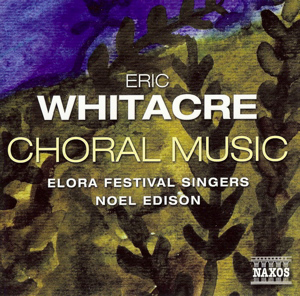
Eric Whitacre: Choral Music Elora Festival Singers, Noel Edison Naxos 8.559677
- Performance:

- Sonics:

Even before his YouTube Virtual Choir recording of “Lux aurumque†(Light of gold) became an international hit, Nevada-born composer Eric Whitacre, 40, had become the golden boy of American choral music. The reasons for his fame, which extends far beyond YouTube, this-is-so-cool status, are abundantly clear to anyone who listens to this new, budget CD from Naxos. Whitacre’s music, with its easily assimilated, almost otherworldly strangeness and ethereal beauty, touches a deep core within our being.
Naxos’s recording, featuring the Elora Festival Singers of Elora, Ontario, Canada under their founder Noel Edison, presents a representative sampling of Whitacre’s work. Chief among the pieces are “Sleep,†a mostly soft, haunting work that comes over you and, almost without your knowing, inhabits your every cell, and “Lux aurumque,†which is almost too gorgeous for words.
The latter work, which I especially favor in its rendition by Cantus, a small, all-male choir headquartered in Minneapolis that include it on While You Are Alive, a superb, demonstration-quality disc recorded by John Atkinson of Stereophile, broke out of the choral ghetto when it appeared on YouTube. That internet rendition began when Whitacre, buoyed by the success of his first Virtual Choir recording, “Sleep,†got the idea to begin with a film of him conducting the work in space, without benefit of musicians or accompaniment.
Next he watched himself conducting, and filled in the piano part. Then he offered sheet music as a free download, and conducted worldwide auditions for the soprano solo. The one-minute video from Melody Meyers from Tennessee scored big in Whitacre’s heart. Finally, when untold hundreds of videos came in with people singing various parts, all following Whitacre’s many changes in dynamics and pacing, he stitched everything together. You can find it here: http://ericwhitacre.com/blog/the-virtual-choir-how-we-did-it.
Naxos’ recording is another matter. In addition to the advantage of rehearsals, and skilled accompaniment by pianist Leslie De’Ath and percussionist Carol Bauman, the Elora Festival Singers boast a truly radiant soprano section that can easily float the highest notes. They also have wonderful control of dynamics. What they did not have, unfortunately, is a recording engineer who could capture sufficient detail in St. John’s Church of Elora. If Naxos ever releases this in Blu-ray surround – their first Blu-ray disc is due out by fall – the diffuse ambience may work to the recording’s advantage. But in stereo, the detail and clarity of Polyphony’s marvelous Whitacre recording, Cloudburst and Other Choral Works (Hyperion), is absent.
Also missing awaiting permission of the publisher, are texts for two songs. You can find the rest at Naxos’ website. Since Whitacre pays great attention to words, which are not easily understood in this diffuse church acoustic, having to either read the words on your computer or other device, or print them out, is a drag. I expect the situation will be different when Decca releases its own, Whitacre-conducted recording in a few months. Meanwhile, the beauty of the Elora Festival Singers’ performances and the spiritual elevation of Whitacre’s music, are self-recommending.
The following reviews first appeared at SFCV.org, the website of San Francisco Classical Voice
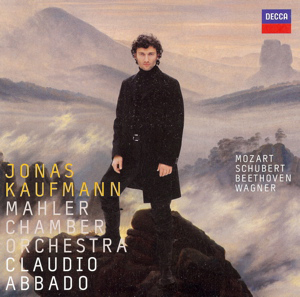
Jonas Kaufmann German Arias – Mozart, Schubert, Beethoven, Wagner Decca 4781463
- Performance:

- Sonics:

Tenor Jonas Kaufmann will likely be your tenor du jour, if not the month, after you hear his new Decca recording of German arias by Mozart, Schubert, Beethoven, and Wagner. Supported and urged on by the Mahler Chamber Orchestra, magnificently conducted by Claudio Abbado, tenor and conductor lavish as much care, love, and passion on their repertoire as you can ever expect to hear.
Kaufmann’s voice is distinctive, as much for its soul as for its smoky, dark bottom and throaty midrange that seamlessly ascend to a brilliant top. There is heart in this voice, heart that sings eloquently in the passionate outpourings of Mozart’s Tamino, Beethoven’s Fidelio, Schubert’s Fierrabras and Alfonso, and Wagner’s Lohengrin, Siegmund, and Parsifal.
The voice is also capable, at age 41, of a winning combination of lyric sweetness and dramatic thrust. Lohengrin’s “In fernem land†(In a far-off land) has rarely sounded so sweet at the start. Seducing with its sensitive phrasing, Kaufmann’s heroic lyric instrument ideally conveys the perfection of the Holy Grail. Equally perfect is Abbado’s hand, as the orchestra literally caresses and cradles the voice as in few recitals. “Mein lieber Schwan!†is just as beautiful as Lohengrin’s Prize Song.
Kaufmann’s voice may not be as pure as an ideal Tamino would sound, but his passion is golden. There’s also a welcome flexibility of tempo, absent from many modern recordings, that only turns metronomic at the conclusion of “Dies Bildnis ist bezaubernd schön†(This picture is enchanting fair). Even better is the extended scene between Tamino and the gentle Speaker of Michael Volle, which is so alive to the moment as to seem excerpted from an actual performance.
Kaufmann says in the liner notes that we will have to wait quite a long while for him to sing the heavier Wagner roles of Siegfried, Tannhäuser, and Tristan. To increase anticipation, he teases us with a gorgeous version of Siegmund’s “Winterstürme†from Die Walküre. Then he leaves us on hold, as Abbado resolves the selection without seguing into Sieglinde’s longed for reply. The Parsifal selections are equally rewarding, even if the Grail could glow more brightly at the end.
In dramatic heroic mode, Kaufmann’s Fidelio clarifies why Leonora is so willing to risk her life for him. Listen to his perfect swell from piano to double forte at the start of “Gott! welch Dunkel hier!†(God! What darkness here). What a voice!
Kaufmann may be extremely photogenic, and heartthrob material from the right angles, but looks alone only sink so far into the heart. Kaufmann sings even better than he can look. With two rarely programmed Schubert arias as the icing on the cake, this is a CD to add to your Great Tenors collection. If you don’t have such a collection, it’s a good place to start.
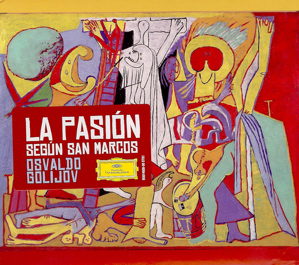
Osvaldo Golijov La Pasión Según San Marcos Deutsche Grammophon 001400800
- Performance:

- Sonics:

Boom! Wham! As the percussion of Orquesta La Pasión, led by Mikael Ringquist and Gonzalo Grau, pounds away, Argentinean-born composer Osvaldo Golijov wastes no time proclaiming that his St. Mark Passion will take a giant step away from the language of J.S. Bach’s monumental achievement.
Commissioned by the Bach Academy of Stuttgart, which in the year 2000, for the 250th anniversary of Bach’s death, commissioned Golijov, Wolfgang Rihm, Sofia Gubaidulina (San Francisco Symphony’s recent Composer-in-Residence), and Tan Dun to compose new settings of Passion segments from all four Christian Gospels, La Pasión Según San Marcos is as awe-inspiring as it is rousing. Written by a Jew who grew up surrounded by classical chamber music, Jewish liturgical and klezmer music, and nuevo tango, and who did not own a copy of the New Testament at the time he received the commission, Golijov’s Passion is part Latin America meets klezmer Afro-Cuban dance party, part performance work, and part oratorio.
It’s also as emotionally gripping as it is thrilling. When seen on the live Holland Festival DVD performance, conducted by Robert Spano, that supplements the far better sounding, two studio-recorded Deutsche Grammophon CDs conducted by the work’s dedicatee, Maria Guinand, it is also theatrically compelling. This is a work that cries out for the higher visual and sonic resolution of blu-ray.
The distinct Latin flavor and brilliant colors of so much of the music, and the delicious voices of “Latin-American alto†Biella Da Costa; Afro-Cuban vocalists Reynaldo González-Fernandez, Gioconda Cabrera, and Manolo Mairena; and less luxuriously titled vocalist Alex Alvear, contrast with the heartfelt purity of soprano Jessica Rivera. A favorite soloist of Golijov and John Adams, who was profiled in SFCV earlier this year [http://www.sfcv.org/events-calendar/artist-spotlight/jessica-rivera-singing-from-the-soul], she first enters about 23 minutes into the piece. In the aria of Judas, “¡Ah! quisiera yo renegar†(I wish to forswear), Rivera’s unadorned sadness instantly transforms the energy of the Passion.
The even more striking section that follows, entitled “The Eucharist,†showcases the women of the Schola Cantorum de Venezuela. To ominous drumbeats, their singing segues into the full chorus’ “Demos Gracias al Señor†(We Give Thanks unto the Lord). As we hear the words (in translation) “Even while the earth trembles…When death comes and captures me…Tremble, tremble earth… We give thanks to the Lord,†the chanting becomes primitive, at times imitating shaking sounds.
If Rivera has the soul of a soprano trained in the European classical tradition – the high-lying arch of her major aria, “Lúa descolorida†(Colorless Moon – Aria of Peter’s Tears), is transfixing – Da Costa has the soul of a Latin vocal goddess. Contrast their voices with the sounds of the chorus toward the end of the work, when they accuse Jesus, smite him on the head, spit upon him, and then worship him with screeches, hisses, and other disquieting effects, and you sense the scope of Golijov’s achievement.
As the crowd/chorus clothes Jesus in a purple robe, and places a crown of thorns on his head, the orchestra goes wild. Complete with a discordant piano and jarring trombones, this orgiastic outburst leads to Jesus’ death, and finally to the Hebrew Kaddish. According to critic Alan Rich, whose liner notes were probably written shortly before his death [see http://www.sfcv.org/article/in-memoriam-alan-rich1924-2010], the audience at the 2000 Stuttgart premiere awarded the work an ovation that lasted over half an hour. As you listen to the CDs, then see the choreography on the DVD, you will know why.

Alondra de la Parra Mi Alma Mexicana (My Mexican Soul) Sony Masterworks 75555
- Performance:

- Sonics:

Mi Alma Mexicana abounds in revelations. That its all-Mexican classic repertoire, which ranges from sedate, 120-year old, European influenced salon music to uncommonly savage modern fare, arrives with such wide-eyed freshness and power owes as much to the abundant gifts of 29-year old conductor Alondra de la Parra as to the artistry of the young members of her six-year old Philharmonic Orchestra of the Americas (POA).
De la Parra, who holds the distinction of being the first female conductor from Mexico to conduct in New York City, chose the 13 works on the program after spending two years researching Mexican music of the last 200 years. Much of what she uncovered is as new to our ears as it was to hers. The two-CD set, released worldwide by Sony on August 3, commemorates the Bicentennial of Mexican Independence.
“Of the 13 pieces,†she explained in a recent phone interview, “there are four best-sellers that everyone knows. These include Moncayo’s Huapango, Márquez’s Danzón 2, the Rosas, and Revueltas’ Sensemayá. The rest is quite new to everyone except the scholars who manage the archives. Even connoisseurs and professional musicians may not be aware of half the CD. I didn’t know the pieces existed, and I’m a Mexican conductor.â€
Let’s start with the arrangement of Juventino Rosas’ Sobre las olas (1884). Who woulda thunk that this carousel-type waltz, which I always knew as the song, “When you are in love, it’s the loveliest time of the year), was Mexican? Although it sounds as Mexican as “My Yiddische Mama,†it’s no more confounding than Gustavo E. Campa’s Mélodie pour violin et orchestre, Op. 1 (1890), which wins the prize for European-sounding sentimental fare suited for gas-lit salons. The contrast with José Pablo Moncayo’s Huapango (1941), which abounds in quintessentially Mexican verve and color, could not be greater.
Recounting all the pieces on the CD will rob you of the joy of discovery. One of the gems, from 2006, is jazz-influenced, while others serve as reminders that Stravinsky once walked the earth. But it’s doubtful that he ever attended a Mexican soccer match, or knew all the authentic cheers that are ingeniously worked into Enrico Chapela’s fabulous Ãnguesu. You may not know them either, but the percussion and effects will nonetheless slam into your gut with savage intensity.
Reviewing from a pre-release pressing, which lacks some of the air and color I hope to find on the final release, I am nonetheless swept away by the breadth and richness of this music. Suppressing a wry smile as I am seduced by Campa’s sensual charm, all the while knowing that it paves the way for Revueltas’ near-phantasmagoric ritualistic passion, I urge you to buy the recording and hear for yourself.


